Visit your favourite destinations |
| A Report from birdtours.co.uk |
A trip to Mauritania, 7-18 February, 2004,
Contact: yufera@easynet.es
,%20Banc%20d%27Arguin%20National%20Park.jpg) |
Caspian Tern (Sterna caspia), Banc d’Arguin National Park. |
Mauritania is a little known and seldom-visited country with very little infrastructure, but it is very safe to travel, it offers some spectacular scenery and, above all for the birdwatching traveller, has the Banc d’Arguin National Park, an area of great importance for wintering and breeding seabirds and shorebirds. Local people are generally pleasant and easy-going, and the country is relatively relaxed for an Islamic republic, enjoying a rather stable parliamentary democracy. The fact that so little is written about the country in terms of birdwatching makes it the more interesting for the adventurous birder willing to find his own birds.
In February 2004 a non-birding friend and I organised an 11-day trip to visit the central areas of the country, plus Banc d’Arguin. We flew with Air Mauritanie from Las Palmas (Canary Islands) to Nouakchott, the capital. The flight stops at Nouadhibou first, a city close to the Banc D’Arguin area that would be the ideal starting point for a more birding-oriented trip.
In Nouakchott we rented a ’95 Nissan Patrol (a 4WD vehicle is mandatory) with driver and guide, through the agency Randonnées Tours (see below for addresses), which we had contacted previously from Madrid. These people offer a number of guided tours in Mauritania, or help you design your own itinerary. They have English-speaking guides available (French being the only widely spoken language in the country, apart from Arabic). The whole package, including accommodation and food, cost €1,300 for 2 people.
Many of the tracks through the desert are dreadful, and in some cases there is simply no track at all. It’s important to make sure that the car you rent has 2 spare tyres at least, plus generous provisions of water. Mauritanian drivers seem to have a happy-go-lucky attitude towards high-speed driving through the desert. We had 4 flat tyres in just 8 days, and considering the way our driver behaved I was surprised that we didn’t have any more serious trouble.
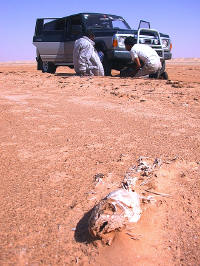
|
The hazards of desert driving. |
Local currency is the ouguiya; at the time, €1=2,33 ouguiyas, officially. A better rate can be found at hotels and travel agencies, and a much better one is offered by the black market exchangers who will pester you around the town market.
We drove through the central mountains and deserts of the region of Adrar and the oasis found along the way to the town of Ouadane, then back through the desert to the coast and Banc d’Arguin. It wasn’t really a birding trip (these are the disadvantages of travelling with sane, normal people); in fact, except for Banc d’Arguin, the area we visited is probably the poorest in the country in terms of bird species. It gets more interesting in the southern area as it gets closer to the Sahel region, with species like Black Scrub-robin, Northern Ground Hornbill, Northern Carmine Bee-eater… that I didn’t get the chance to see. However, the landscapes are beautiful, ranging from endless sand dune extensions to rugged mountains and canyons, all in a rather mild climate that in some areas could get really cold at night.
Rather than a day-by-day report what follows is a commented birdlist, with details on the most interesting species I found in the trip and the places where I saw them, plus a more detailed account on Banc d’Arguin.
Some useful addresses:
- Randonnées Tours. 22, Avenue Charles De Gaulle, BP 4992, Nouakchott, Mauritania. Ph. (222) 525 95 35, fax (222) 525 95 39.
- Direction du Parc National du Banc d'Arguin. Av. Gamal-abdel-Nasser, BP 5355, Nouakchott. Ph. (222) 25 84 41, fax (222) 25 85 42. e-mail: pnba@mauritania.mr
- Hotel Halima. BP 5144, ph.(222) 25 79 20 (near the Presidence building). This is where we lodged when in Nouakchott. Good value for around 20,000 ouguiyas. Has a bar, but no alcohol served. For a beer, the bar in the much more expensive Hotel Mercure is just around the corner, again in Av. Gamal-abdel-Nasser, ph. (222) 25 50 50.
Books: Field guides.
Mauritania is only partially included within the Western Palearctic, and it’s not considered as part of North Africa by many authors. Therefore it’s in a sort of zoogeographical limbo, and it’s not easy to find specific literature about its fauna.
- The bird guide used in the trip was the new (2003) Birds of Africa South of the Sahara, by Ian Sinclair and Peter Ryan (Struik, Cape Town, S. Africa). This is a very good book and, considering the range covered, not too bulky to be carried around.
- Amphibians and Reptiles of North Africa. H. H. Schleich, W. Kästle & K. Kabisch, Koeltz Scientific Publishers, Koenigstein, Germany (1996). An excellent reference book, covering Morocco, Lybia, Tunisia and Egypt.
- In French: Guide des Oiseaux du Parc National du Banc d'Arguin. P. Gowthorpe, B. Lamarche, et al. Published by the Direction du Parc National du Banc d'Arguin (1996), it can be bought at its office (see address above). Describes the park and gives a detailed account of all the bird species found, their status and numbers, including photos. A good buy if you are lucky enough to find the Park's office open; if not, try the bookstore in Av. Gamal-abdel-Nasser, where this and other interesting titles on the region can be found, including the one below.
- Also in French: Entre le Sahara et l'Atlantique: Le Parc National du Banc d'Arguin. Pierre Campredon (FIBA / WWF, Arles, 2000. ISBN 2-9514914-0-9). A beautifully published softcover book with excellent photos, about the park, its wildlife and its human population.
Books: Travel guides.
- Lonely Planet: West Africa, 5th edition. M. Fitzpatrick, A. Burke, et al. (2002). As usual, the basic and most widely used reference.
- In French: Objectif Aventure: Mauritanie. Bernard Nantet (Arthaud, Paris, 2001).
- In Spanish: La Guía de Marruecos y Mauritania. Roger Mimó (Distrimapas Telstar, Barcelona, 1999).
Maps:
The one I could find in Madrid was the 1:2,000,000 map published by International Travel Maps, which proved quite good. As usual with Arabic-speaking countries, caution is needed with the names of places, since they can be spelled or even named differently depending on the signpost, map or person of source; for instance, we saw the village at the entrance of Banc d’Arguin as Amghar, Nouamghar and Mamghar. In the following account I use the names that appear in the map, although they’re usually different to those used by local people or even official signposts (see photo below).
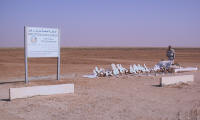 |
Whale skeleton at the entrance of the Park, Mamghar. |
The Banc d’Arguin National Park is an Atlantic coastal area comprising some 12,000 km2 between sea, protected seashore (at least in theory), and islands. For a detailed set of statistics and data concerning the park, take a look at http://whc.unesco.org/sites/506.htm.
For a birdwatcher, the Park's appeal lies not so much in the particular species that can be found (especially for a Spanish birder, since practically all of them can be seen at home) as in their sheer numbers. Where in the following list I write “common at Banc D’Arguin” after a species, it means by the thousands, or by the hundreds of thousands in some cases. The park has an estimate bird population of 2,5 million, of which 2,3 million are Palearctic shorebirds, the largest concentration in the World. Particularly numerous are small shorebirds, such as Sanderling and Ruddy Turnstone, which gather in large flocks around the garbage that invariably surrounds every village and settlement along the coast. The numbers of terns are also huge, Caspian being the most notable, followed by Sandwich, Gull-billed and Little. Royal were less numerous and Bridled, sadly, totally absent at the time of our visit; they arrive in the area to breed, in March-April.
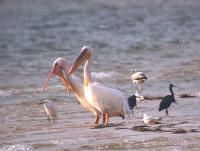 |
Great White Pelican, Western Reef Egret, Little Egret, Greater Flamingo, Slender-billed Gull. |
The coastline inside the park is very long (some 290 kms), so birds have room to scatter around, and during the day they are found in small but very diverse groups: Pelicans, Flamingos, Cormorants (White-breasted and Long-tailed), many different shorebirds, Gulls (Slender-billed, Black-headed and Lesser Black-backed), and assorted terns and herons. It's in the early morning hours that one can see the enormous flocks that fly from the offshore islets where they sleep to the mainland and the coastal mudflats. For this, boat rides are available using the local fishermen’s sailboats from the village of Louik (or Iwik, as locals seem to call it…). They leave shortly after dawn (if your boatman doesn’t oversleep, as mine did) and take about 2-3 hours, although you can negotiate a longer trip. A park ranger always goes in the boat, together with the skipper and a boy in charge of preparing an endless supply of tea (which comes in handy, since it can be chilly in the early morning). The ride is truly fantastic; since the boats don’t have motors there is no other noise apart from the sea and the, literally, millions of birds flying low over the water to reach their feeding grounds.
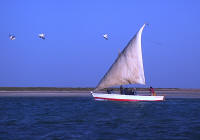 |
Fisherman’s boat and Great White Pelicans. |
A permit is necessary in order to access the Park. It can be obtained at the Park’s office in Nouakchott (see address above); in our case our agency did it for us. Driving north from the entrance of the Park in Nouamghar, in the small village of Louik, there’s a small tourist camp facing the sea, its nearby beach full of shorebirds and an excellent watchpoint for dolphins and seabirds. Facilities are very basic, and lodgings consist in tents. Within walking distance there is a small settlement from which the boats depart. As with every other human habitation throughout the country, there is garbage all around, but birds seem to appreciate it.
There are some 1,000 human inhabitants within the park limits, mainly of the Imragen ethnic group. Traditionally these people were nomadic fishermen, but nowadays they live in squalid settlements hardly deserving to be called villages. Official literature presents them as an idyllic example of human coexistence with nature, an image somewhat spoilt by the huge quantities of garbage and rotten fish surrounding the settlements, and by the general impression of extreme poverty and destitution. However, it’s possible that I missed some other settlements that may be in a better state. For details on the Imragen, you may check: http://www.afrol.com/Countries/Mauritania/backgr_Imraguen.htm
Further North from Louik there’s another settlement (some of these are so small that don’t seem to have a name) in which you can rent a large jaima, positively luxurious after the dinghy tents of Louik’s camp. This seems to be a supplemental source of income for local women, who pitched and prepared it at the end of a small peninsula, far away from the village, where huge numbers of pelicans, terns and shorebirds gathered to sleep. In the morning we were awakened by their noise.
That is as far as we went; my non-birding friend was starting to grumble to himself, probably plotting to dump me and my telescope into some rubbish heap and take off with the car. Besides, we were running out of time and had a predictably exhilarating drive ahead of us before reaching Nouakchott (indeed, we had yet another flat tyre even before leaving the park, and were forced to spend half a day flywatching in the shanty outskirts of Nouamghar). Continuing North along the coast one can reach the Cap Blanc, where reportedly Sudan Golden Sparrow can be found, and where the last couple of hundred remaining Monk Seals of the Mediterranean still live. Certainly more than enough reason for another trip, preferably in the breeding season.
Birdlist:
Great White Pelican (Pelecanus onocrotalus). Common at Banc d’Arguin.
White-breasted Cormorant (Phalacrocorax lucidus). Common at Banc d’Arguin
Long-tailed Cormorant (Phalacrocorax africanus). Common at Banc d’Arguin
..jpg) |
“Pale” Grey Heron (Ardea cinerea monicae). |
Gray Heron (Ardea cinerea). Both the nominal Palearctic subspecies and the distinctive, very pale endemic subspecies A. c. monicae (see photo) are common at Banc d’Arguin.
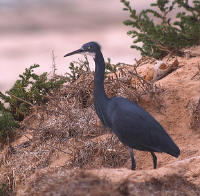 |
Western Reef Egret. |
%20and%20Western%20Reef%20Egret..jpg) |
“Common” Grey Heron
(A. c. cinerea) and Western Reef Egret. |
Western Reef Egret (Egretta gularis). Common at Banc d’Arguin, with an estimated population of 1,500.
Little Egret (Egretta garzetta). Common at Banc d’Arguin.
Eurasian Spoonbill (Platalea leucorodia). Both the nominal form and the local endemic subspecies P. l. balsaci, lacking the yellow bill spot, are common at Banc d’Arguin.
Greater Flamingo (Phoenicopterus rubber). Common at Banc d’Arguin.
Osprey (Pandion haliaetus). Common at Banc d’Arguin. In certain stretches of the road to the park along the coastline, roughly one specimen can be found every 600-700 metres, sitting on the beach. They were also seen fishing during the boat ride from Iwik.
Black Kite (Milvus migrans). Frequently found in desert and semi-desert areas, flying singly or in groups, probably on migration northward.
Western Marsh Harrier (Circus aeroginosus). One at Banc d’Arguin.
Eurasian Kestrel (Falco tinnunculus). One flying near Ouadane, along the oued (a dry river bed; what in Arabia is called wadi) that seemed some kind of northbound route for migrants.
Lanner Falcon (Falco biarmicus). One near the town of Chinguetti, sitting on a sand dune, and several seen along desert roads.
Peregrine (Falco peregrinus). One perched on the island facing the tourist camp in Louik, in Banc D’Arguin.
Eurasian Oystercatcher (Haematopus ostrelagus). Common at Banc d’Arguin.
Eurasian Thick-knee (Burhinus oedicnemus). Several pairs around the camp at Banc D’Arguin.
Cream-colored Courser (Cursorius cursor). Several pairs seen along the road in the Adrar area.
Black-bellied Plover (Pluvialis squatarola). Common (although not in great numbers) at Banc D’Arguin
Ringed Plover (Charadrius hiaticula). Common at Banc d’Arguin.
Kentish plover (Charadrius alexandrinus). A few in the beach near Nouakchott, and also in Banc d’Arguin.
Bar-tailed Godwit (Limosa lapponica). Common at Banc d’Arguin.
Whimbrel (Numenius phaeopus). Common at Banc d’Arguin.
Common Redshank (Tringa totanus). Common at Banc d’Arguin.
 |
Common Greenshank and Little Tern. |
Common Greenshank (Tringa nebularia) Common at Banc d’Arguin.
Common sandpiper (Actitis hypoleucos) Common at Banc d’Arguin.
Ruddy turnstone(Arenaria interpres) Common at Banc d’Arguin.
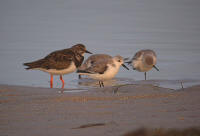 |
Ruddy Turnstone and Sanderling. |
Red knot (Calidris canutus) Common at Banc D’Arguin.
Sanderling (Calidris alba). Common at Banc D’Arguin. Especially numerous around garbage in human settlements.
Little Stint (Calidris minuta). Common at Banc D’Arguin.
Curlew Sandpiper (Calidris ferruginea). Common at Banc D’Arguin.
Dunlin (Calidris alpina). Common at Banc D’Arguin.
Lesser Black-backed Gull (Larus fuscus). Common at Banc D’Arguin.
Black-headed Gull (Larus ridibundus). Common at Banc D’Arguin.
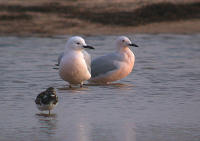 |
Slender-billed Gulls and Ruddy Turnstone. |
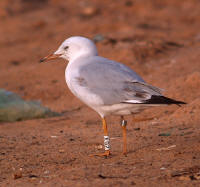 |
Slender-billed Gull, 1st
winter. |
Slender-billed Gull (Larus genei). Common at Banc D’Arguin.
Gull-billed tern (Sterna nilotica). Common at Banc D’Arguin.
Caspian tern (Sterna caspia). Common at Banc D’Arguin.
Sandwich Tern (Sterna sandvicensis). Common at Banc D’Arguin.
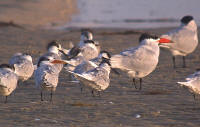 |
Royal, Sandwich, and Caspian terns. |
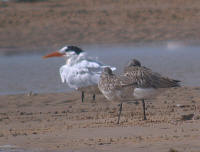 |
Royal Tern and Bar-tailed Godwit. |
Royal tern (Sterna maxima). Found at Banc D’Arguin, but in much smaller numbers than the previous species. Usually 2-3 would be found in a group of hundreds of other terns.
Little tern (Sterna albifrons). Common at Banc D’Arguin, again in smaller numbers.
Speckled pigeon (Columba guinea). One in Nouakchott.
African Collared Dove (Streptopelia roseogrisea). A few around the oued at Ouadane.
Laughing Dove (Streptopelia senegalensis). Common throughout.
Great Spotted Cuckoo (Clamator glandarius). Several seen in the trees in the oued at Ouadane, probably on migration northwards. Both adults and subadults.
Pallid Swift (Apus pallidus). Common in Nouakchott.
Bar-tailed Lark (Ammomanes cicturus). One seen at the roadside from Banc d’Arguin to Nouakchott.
Desert Lark (Ammomanes deserti). Several seen on hillsides in Terjit and the fort Saganne.
Greater Hoopoe Lark (Alaemon alaudipes). Individuals and pairs were frequently heard and seen in desert areas .
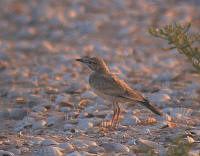 |
Greater Hoopoe Lark (juvenile). |
Dunn’s lark (Eremalauda dunni. Several pairs seen in the bush desert between Chinguetti and Ouadanne. Bold and curious, they would fly around me at eye level, calling loudly.
Crested Lark (Galerida cristata). A pair in the village of Amghar, at the entrance of Banc d'Arguin.
Rock Martin (Hirundo fuligula). Common in rocky areas and towns.
Barn Swallow (Hirundo rustica). Several pairs and single specimens seen flying over desert areas, probably on migration.
White Wagtail (Motacilla alba). Several seen around human habitations.
Yellow Wagtail (Motacilla flava iberiae). Several pairs at Banc d'Arguin.
Re-throated Pipit (Anthus cervinus). One at banc D’Arguin.
Subalpine Warbler (Sylvia cantillans). One seen in the trees on the road from Nouakchott to Chinguetti.
Spectacled warbler (Sylvia conspicillata). A pair seen near the road between Nouakchott and Chinguetti, where an area of trees and orchards near a gas station seems to be a migrant magnet.
White-crowned Black Wheatear (Oenanthe leucopyga). Very common throughout the interior. The most commonly seen bird away from human settlements (where only House Sparrow outnumber it).
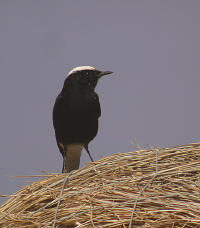 |
White-crowned Black Wheatear, male. |
Northern Wheatear (Oenanthe oenanthe). A few seen in semi desert areas.
Isabelline Wheatear (Oenanthe isabellina). A few seen in semi desert areas, on the road from Nouakchott to Chinguetti.
Fulvous Babbler (Turdoides fulvus). A few seen around farms in Chinguetti and Atar.
Southern Grey Shrike (Lanius meridionalis). Several seen in bush and semi-desert areas.
Brown-necked Raven (Corvus ruficollis). Common in desert areas, their calls being the most characteristic sound of the sand dune desert.
House sparrow (Passer domesticus). Common in all towns and human settlements.
Desert Sparrow (Passer simplex). One of the species I was eagerly looking for. Only one pair seen, looking for food at the small village of Tanouchatt. While trying to get a photo of the male, a local woman protested, thinking I was trying to photograph her. When I finally convinced her that it was the bird’s picture I wanted, she looked at me like I was dangerously insane.
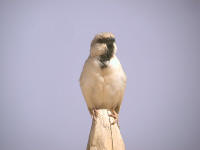 |
Desert Sparrow, male. |
Trumpeter Finch (Bucanetes githagineus). A couple of small groups seen in the rocky hills around Terjit, and also near the Saganne colonial fort, usually mixed with House Buntings.
House Bunting (Emberiza striolata). Seen around several villages and camps in the desert. Especially numerous in and around the oasis of Terjit.
Mammals:
Northern Pygmy Gerbil (Gerbillus sp.). Any night walk in desert areas would produce a good number of these diminutive rodents. They inhabit small burrows concealed at the base of bushes, and move so fast that it’s hard to tell whether they run or jump.
Jird (Meriones sp.) Common around the camp at Banc d’Arguin. They inhabit burrows at the base of bushes. Mainly nocturnal, but they are curious and not too shy, and frequently emerge during the day to feed and take a look around.
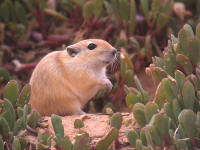 |
Jird. |
Gundi (Felovia vae). A charming, strange-looking rodent found in rocky areas around Ouadane, and near Fort Saganne. At a distance I took them for Hyraxes, but they are smaller and have short, bushy upturned tails. Their faces are very peculiar, with eyes positioned backward in the head close to very small ears and long, blunt snouts. They run along rocks, so fast that I couldn’t take any good photos, and hide in crevices. Once located they aren’t difficult to observe, especially in the late afternoon, if one stays quiet.
Red-headed Rock Hyrax (Procavia ruficeps). One family group seen in rocky outcrops in the oued near Ouadane. They didn’t look very “red-headed”, but according to Kingdon this is the species found in the area.
Reptiles & amphibians:
Toad (Bufo sp. (mauritanicus?)). One seen at the oasis in Tarjit. Similar to some B. mauritanicus I’ve seen before, but with less defined markings.
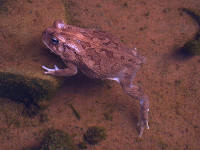 |
Bufo sp. |
Spiny-tailed lizard (Uromastyx acanthinurus). Very common in the rocky slopes around Ouadane, and almost anywhere with large rock boulders. They continuously crossed the road in front of our car, so fast that despite his obvious efforts our driver couldn’t run over any of them.
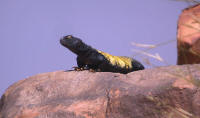 |
Uromastyx acanthinurus. |
Wall gecko (Tarentola mauritanica). Only one seen, in the camp at Ouadane.
Ground gecko (Stenodactylus sp). Another beautiful reptile that I haven’t been able to identify with certainty. Found during a night walk when camping near the village of Bennichab. (I would really appreciate any suggestions as to the correct ID of the above toad and gecko).
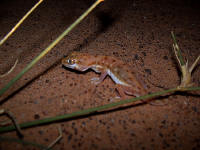 |
Stenodactylus sp. |
Why not send us a report, or an update to one of your current reports?